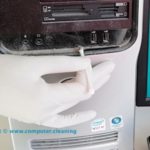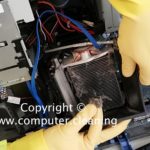A recent employment survey found that 690,000 people are employed as cleaners in the UK, 558,000 of whom are women. Over 3,000 serious accidents involving cleaners are reported to the Health & Safety Executive (HSE) each year. Under-reporting means that this figure is likely to be much higher.
Cleaners are employed in all workplaces, including schools, offices, hospitals and retail outlets. Cleaners employed by private contractors are likely to work in a variety of workplaces, while in-house cleaners usually work in the same environment.
Cleaning staff are often employed in workplaces that have been planned with other workers in mind, and very little thought has therefore been given to their needs. This can create a number of health and safety problems for them. For example, unsuitable storage facilities, the location of taps and floor materials, and inadequate access and exits. Cleaners are also expected to carry equipment up and down stairs.
Cleaning work is demanding, and changes within the industry mean that cleaning staff work under tight deadlines. Many cleaning tasks involve heavy manual work and are physically demanding. Cleaners are often required to use heavy cleaning equipment, such as buffing machines and vacuum cleaners. In addition, cleaners have a wide range of other tasks which can include mopping, wiping surfaces and moving furniture around.
Employers’ legal duties
Under the Health and Safety at Work Act (HASAWA) 1974 and the Management of Health and Safety at Work Regulations (MHSW) 1999, employers have a legal duty to assess all risks to the health and safety of employees, including cleaning staff. If the risk assessment shows that it is not possible for the work to be done safely, then other arrangements must be put in place. Read further about the Employers’ legal duties
Risk assessment: what your employer must do
Any risk assessment must be wide-ranging and take into account the different types of tasks carried out by cleaners. This includes using, moving, lifting and carrying materials and equipment (such as vacuum cleaners, floor buffers, buckets, mops and rubbish bags); the chemicals used for cleaning and disinfecting; and any personal protective equipment supplied. Read further about risk assessment
Common health and safety problems
Some of the common health and safety issues faced by cleaners are set out below. There will be others, and safety representatives will need to ensure that cleaning staff are included when any risk assessments are carried out.
Hazardous chemicals and other substances
It is common for cleaning staff to use a number of hazardous substances. Cleaning fluids such as floor, toilet and window cleaners, bleach and polishes are regularly used. Read further about the Hazardous chemicals
Dermatitis
One of the main health and safety risks to cleaning staff is dermatitis. Dermatitis is an inflammation of the skin and is sometimes called eczema. The main symptoms include itching, cracking, blistering and ulceration. Read further about dermatitis
Manual handling
The most common injury at work for cleaning staff is caused by manual handling. A survey has found that 20 per cent of cleaners using floor-buffing machines, mops and vacuum cleaners needed time off work because of aches and pain caused by using the equipment. The survey showed that over half of all cleaners had sought medical advice because of injuries. Read further about Manual handling
RSI and WRULDS
Repetitive strain injury (RSI) covers a wide range of injuries to muscles, tendons and nerves. Usually, hands, wrists, elbows or shoulders are affected. However, knees and feet can also suffer, especially if the job involves a lot of kneeling or operating foot pedals on equipment. Read further about RSI and WRULDS
Checklist for safety representatives
Does the work involve:
■ Awkward movements of the hand, wrist, arm or shoulder?
■ Rapidly repeated movements?
■ Prolonged physical pressure, such as gripping or squeezing?
■ Holding an uncomfortable position for a long time?
■ Lack of variety of physical tasks?
■Is health and safety information and training provided to cleaning staff?
Are the problems:
■ Reported to management?
■ Recorded in the accident book?
Hand-arm vibration syndrome (HAVS)
Some equipment used by cleaner, for example, floor cleaning machines can cause hand-arm vibration syndrome (HAVS). The Health & Safety Executive research found that cleaning staff are potentially exposed to HAVS when using floor-buffing machines. Read more about Hand-arm vibration syndrome (HAVS)
Checklist for safety representatives
Are tools and equipment:
■ Too heavy?
■ The wrong shape to be comfortable?
■ Designed for men but used by women?
■ Do they vibrate?
Is training:
■ Adequate?
■ Provided when there is a change in the equipment or work method?
Is information provided to cleaners on:
■ The risk of HAVS?
■ The symptoms and what to do if they occur?
Is there a recording and reporting system in place?
Lone working
Some cleaners may work alone often they clean premises before workplaces are open, or after they have closed in the evenings, or late at night when the rest of the workforce has left. Read more about Lone working
Fire and Electrical safety
PPE Personal protective equipment and clothing
Cleaners may be issued with personal protective equipment (PPE), or clothing to protect them while at work. Read further about PPE
Cleaners’ duties
It is important that cleaners are given a clear description of their duties. If this includes any special tasks, they must have proper training, information and equipment to do the job safety. It should be made clear to cleaning staff that where such tasks are not listed as their duty, they should not do them, but seek further advice. This will help to protect cleaners from exposure to potential health hazards.





